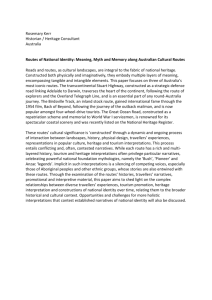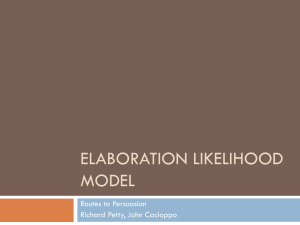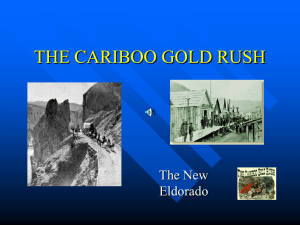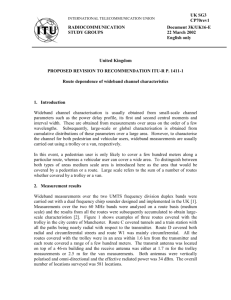Council of Europe Cultural Routes: Good Idea but Bad Realization
advertisement
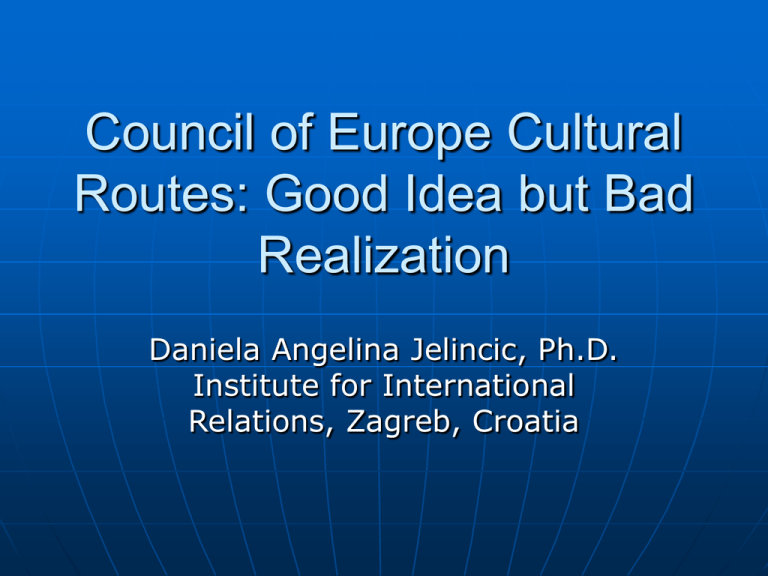
Council of Europe Cultural Routes: Good Idea but Bad Realization Daniela Angelina Jelincic, Ph.D. Institute for International Relations, Zagreb, Croatia Council of Europe and Cultural Tourism One of the pioneers in initiatives concerning European cultural integrations and European identity Culture as a strong link of European nations Linking culture with tourism Cultural Routes Already in 1960. the idea of discovering the ‘Others' through travel Focus on cultural tourism as the best way of spending free time Not only a visual aspect and illustration of basic knowledge taught in schools but also as a social experience and an opportunity for individual sensibility development Key objectives of the Program to raise awareness of a European cultural identity and European citizenship; to promote intercultural and interreligious dialogue through a better understanding of European history; to safeguard and enhance the cultural and natural heritage as a means of improving the quality of life and as a source of social, economic and cultural development; to give pride of place to cultural tourism, with a view to sustainable development. Definition of a Cultural Route A route which includes two or more countries or regions and is organized on a theme whose historical, artistic or social interest is European, either according to the geographical route’s features it follows or according to its nature and/or significance. The route is based on multitude of features which present European culture as a whole, and it includes destinations rich in historic associations. Benefits of the Program To advance solidarity and tolerance, To advance exchange of partners from different countries, To advance cooperation at the institutional level, To advance development of tourism as to contribute to economic development of the countries Themes I The Pilgrim Pathways Rural Habitat Silk – textile Baroque Monastic influence The Celts Historic and legendary persons (Mozart, Schickhardt, Don Quixotte) Themes II Vikings and Normans Hanseatic sites Parks and gardens Cities of discoveries Living arts The Phoenicians The Gypsies humanism Themes III Fortified military architectures The Legacy of al-andalus The Northern lights Popular festivals and rites Book and writing Castillan language European Jewish heritage Migration heritage Themes IV Industrial heritage Olive tree Saint Martin of tours The Via Regia Transromanica – Romanesque heritage in Europe Characteristics of the Program Identified across Europe, Labeled by common labels, Have common promotional activities, Have common promotional materials and maps. Common label Cooperation With other bodies of the Council of Europe With the international organizations (UNESCO, EU) with national governments (countries signatories of the Cultural Convention which participated in the creation of routes), regional and local governments, NGOs and universities Criteria I Presentation of European values common to several European countries; Themes developed by a multidisciplinary team of experts from different European regions; Illustration of European history and heritage and contribution to diversity of today’s Europe; Criteria II Stimulation of cultural and educational youth exchange; Initiatives and innovation within the area of cultural tourism and cultural development; Implementation of long-term multilateral cooperation projects through multidisciplinary networks located in Council of Europe members states. European Institute of Cultural Routes Established in 1997 in Luxemburg Responsible for the continuity and for the development of the Program Serves as a technical agency preparing studies, reports, exhibitions, publications Processes propositions for new themes and activities Evaluates and coordinates networks responsible for the Program Importance of the Program Promotion of the idea of the European identity Promotion of tolerance, common values and intercultural dialogue Influence on national tourist programs development Cultural Routes in numbers 2007 Total budget - 96,129,988 Euro Total visitors in sites – 5,907,000 Cca. 16 Euro average per person Total number of heritage rehabilitation projects – 45 Total number of events – 998 Total number of full time employees – 108 Total web visitors – 1,610,784 Criticism of the efficiency of the Program I The Program is not widely recognized Low visibility of the Program for the target users Promotion of routes is the task of the countries which make part of the route. CoE helps in criteria and establishing the route, but not in the promotion. Partly, the Institute for cultural routes takes its role in the marketing, but it is not allowed to lobby for a single route but the Program as a whole Criticism of the efficiency of the Program II CoE insists on the fact that cultural routes are not a tourist product and does not undertake any promotional activities in this direction According to CoE, the Program is established with the idea of European identity promotion as its primary objective Criticism of the efficiency of the Program III The popularity of the first pilgrim pathway of Santiago de Compostela put the other routes on a less visible map Criticism of the efficiency of the Program IV It is hard to measure if some tourists travelled for the Program or visited some of the destinations on the route because they were already there for some other reasons Too big budget compared to the number of visitors
